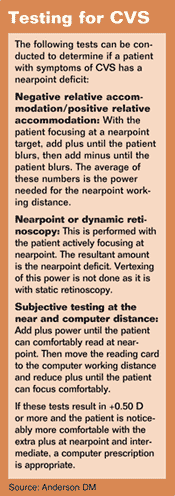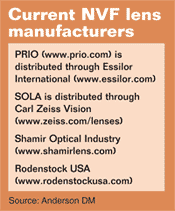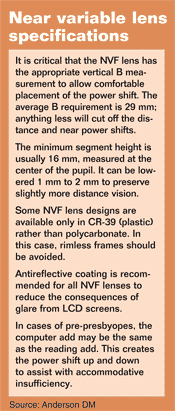Solutions are available for your CVS patients
Contact Lenses and Eyewear
|
|
   |
Today’s world is full of computers. You see them in the workplace, in schools and in recreational settings such as sporting events.
The human visual system, however, is not designed for extended hours of computer viewing. Our eyes are not accustomed to focusing accurately on pixels, the tiny dots of light that make up computer display images. Symptoms such as blurred vision, dryness, burning, headaches and eyestrain are commonly reported. These symptoms are collectively known as computer vision syndrome (CVS).
It is estimated that 75% of computer users experience some form of CVS. The prevalence increases to 90% when computer use exceeds 3 hours per day.
Many times, patients with CVS do not attribute their symptoms to computer use. The most common complaints are headaches and blurred distance vision at the end of the day or when driving at night. These symptoms may be reduced on weekends or while on vacation.
How do we as eye care providers properly diagnose and treat this growing epidemic? The accompanying chart shows a number of diagnostic test options.
Treatment options
The simplest treatment option is to prescribe a single vision lens with the power needed at the working computer focal point. This works well for non-presbyopes.
In presbyopes, however, a near variable focus (NVF) lens is a good option. These lenses are a progressive design with the computer prescription centered over the pupil. The horizontal width for most designs is 16 mm, as compared to 4 mm with standard progressives. There is a power shift up for a diluted distance prescription and a shift down with extra prescription for reading. These lenses even work well for current lined bifocal wearers due to the wider intermediate zone and comfortable power shifts.
A general guideline for determining the prescription needed at the computer distance is to take half of the patient’s nearpoint prescription and add 0.25 D. For example, if a patient requires a +1.50 D at nearpoint, +1.00 D would be specified as the computer add. This may vary if the patient has unusual working demands.
Keep in mind that NVFs do not take the place of the patient’s habitual distance prescription and should be considered a specialty design for computer and near work. These lenses may also be prescribed for use over a patient’s contact lenses. The NVF prescription must be appropriately calculated for the corrected distance vision with contact lenses. See the accompanying chart for a list of several NVF lens manufacturers.
Other options for NVFs
As you become more comfortable with prescribing NVFs, you will realize the many advantages as well as various applications. NVF lenses work especially well in presbyopic emmetropes, post-cataract surgery patients and patients with anisometropia. Anisometropes tend to do better with progressives because the lenses eliminate image jump and the need for slab-off as with standard lined bifocal designs. Musicians and hobbyists also enjoy the benefits of NVF lenses.
With the prevalence of computer use, it is a great advantage for you to learn more about the option of NVF lenses for your patients suffering from CVS. Understanding and prescribing these lenses will set you apart from the average practitioner.
For more information:
- Dianne M. Anderson, OD, practices in a multispecialty group of optometrists. She can be reached at LensCrafters, 1298 Fox Valley Center, Aurora, IL 60504; (630) 851-8302; fax: (630) 851-8329; dianne.anderson@comcast.net. Dr. Anderson has no direct financial interest in the products mentioned in this article, nor is she a paid consultant for any companies mentioned.
References
- Kolker D, Hutchinson R, Nilsen, E. Comparison of tests of accommodation for computer users. J Am Optom Assoc. 2002;73(4).
- Daum KM, Clore KA, Simms SS, et al. Productivity associated with visual status of computer users. School of Optometry, UAB, and College of Optometry, The Ohio State University; 2006.

